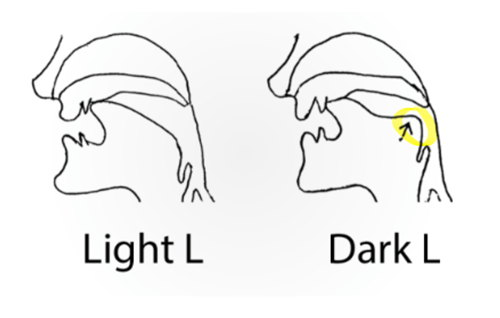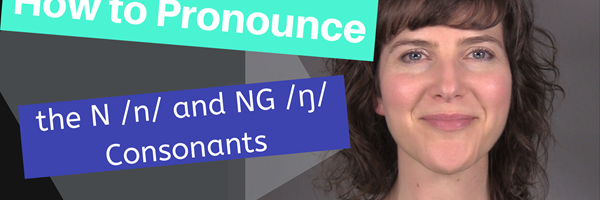*Continue your Dark L pronunciation practice with my additional pronunciation lessons on the Dark L and Light L consonants: How to Pronounce the Light L and Dark L Sounds; How the Dark L Influences Vowels; Your #1 Go-To Guide to the Dark L; How to Pronounce the L /l/ Consonant; Advanced English Pronunciation Practice: The Dark L.
There are a few sounds in American English that are consistently tricky for most of my clients, but one that also deserves a spot at the table is the L sound. I’ve found this sound to be especially tricky for my Chinese, Vietnamese, and Japanese clients.
The Light L
The American L has two pronunciations depending on where it is in the word. When the L is at the beginning of a word (like in love and look) or at the beginning of a syllable (like in elongate and release), it is called the light L. The IPA transcription for the light L is /l/.
Of the two pronunciations for L, the light L may be easier to pronounce correctly because the tongue positioning is a little less complicated. To make this sound, place the tip of your tongue behind your front teeth or at the bumpy ridge just behind your front teeth (called the alveolar ridge). Alternatively, the tongue tip can also come out past your front teeth.
The tongue should be in a narrow shape to allow the airflow to travel around the sides of the tongue. The tongue retracts back into the mouth, and the back of the tongue drops low into the mouth. The light L may feel like it is being made towards the front of the mouth.

The Light L
Here are some example words for the light L: love, light, live, language.
The Dark L
When L is at the end of a word (like in ball and able) or at the end of a syllable (like in pillow and dollhouse), it is called the dark L. The IPA transcription for the dark L may be /l/ or /ɫ/, depending on who has written the transcription. The dark L is usually the more difficult L to pronounce correctly because of the tongue positioning.

The Dark L
The tongue positioning for the dark L starts out similar to the light L: the tongue tip is up behind the top front teeth (but it does not pass the front teeth, like the light L can), and the tongue is pulled back into the mouth. But the difference is what is happening with the back of the tongue. The back of the tongue should lift up slightly towards the soft palate as you make this sound, and you should feel a bit of tension in your throat and tongue. It is still back in the mouth, but there’s a slight lift upward. You may even feel like the dark L is made in the throat, not in the mouth.
Focus on the back of the tongue - if you don’t pull it back far enough, you won’t be able to produce the correct sound. The dark L might feel and sound a bit strange at first - and it is!
Here are some example words for the dark L: ball, hill, able, real.
Another difference with the dark L is there is a small vowel inserted just before the L, but it is not transcribed in the IPA. Listen to how I say those example words again. Do you hear a small UH sound before the L? I’m really saying this: ba-uhl, hi-uhl, a-buhl, rea-ul. You should also hear the intonation change in my voice as I say those words: my pitch drops down at the end.
What about the lips? The “oh” substitution
Since the dark L does not exist in all languages, some of my clients will substitute the closest sound they have in their native language for the American dark L. That’s usually the vowel sound OH, like in “baw-oh” for ball. There are two articulation errors that are being made in this case: 1) The tongue tip has been lowered and the tongue base has been fully raised (which is the opposite of the tongue positioning for the dark L), and 2) the lips have usually been rounded to make the OH sound.
As described above, the tongue positioning for the dark L is made with the tongue tip up and the tongue pulled back into the mouth, which is the opposite in the sound OH. The lips are not used for the dark L; rather, the lips stay neutral for this sound. You can even smile as you say the dark L, and it will still sound correct.
Here are some words that are said with the correct dark L and the substituted OH sound. See if you can hear the difference:
You may not be able to hear the difference yet, but if you practice with a mirror you should be able to see the difference in your lip and tongue placement. Make sure you aren’t rounding your lips when you say the dark L, and look (and feel) for your tongue tip to come up to the back of your front teeth.
Another handy tip to help with the dark L: add the vowel UH at the end of the word to train your tongue to come up to the right spot. Then slowly fade out the UH as you become more consistent with the correct tongue placement.
Ball + uh
Tall + uh
Call + uh
Thanks so much for watching! And I'd love to hear from you - contact me to learn how we can work together to perfect your American English pronunciation!
******************************************************************************************************
Interested in more American English pronunciation practice? Be sure to check out some of my most popular online resources (all free!):
- Dark L and Light L exercises: Free, downloadable and printable pdf
- Semi-Occluded Vocal Tract (SOVT) exercises: Free, downloadable and printable pdf
- Stressed and Unstressed Syllables exercises: Free, downloadable and printable pdf
- AH /ɑ/ and UH /ʌ/ Vowel pronunciation exercises: Free, downloadable and printable pdf
- American R /ɹ/ Consonant pronunciation exercises: Free, downloadable and printable pdf
- Vowel to Vowel Linking exercises: Free, downloadable and printable pdf
- Consonant to Vowel Linking exercises: Free, downloadable and printable pdf
- Word Reductions and English Rhythm exercises: Free, downloadable and printable pdf
- N /n/ and NG /ŋ/ Consonant pronunciation exercises: Free, downloadable and printable pdf
- Respiratory and Breath Support exercises: Free, downloadable and printable pdf
- International Phonetic Alphabet (IPA) for English Vowels: Free, downloadable and printable pdf
- International Phonetic Alphabet (IPA) for English Consonants: Free, downloadable and printable pdf
- Resonatory and Vocal Projection exercises: Free, downloadable and printable pdf
- Articulatory and Tongue Twister exercises: Free, downloadable and printable pdf
- Glottal Stop T /ʔ/, Flap T /ɾ/, and True T /t/ exercises: Free, downloadable and printable pdf
- EE /i/ and IH /ɪ/ Vowel pronunciation exercises: Free, downloadable and printable pdf
- Presentation Skills Training exercises: Free, downloadable and printable pdf
- Sentence-level Stress and Content Word Stress exercises: Free, downloadable and printable pdf



